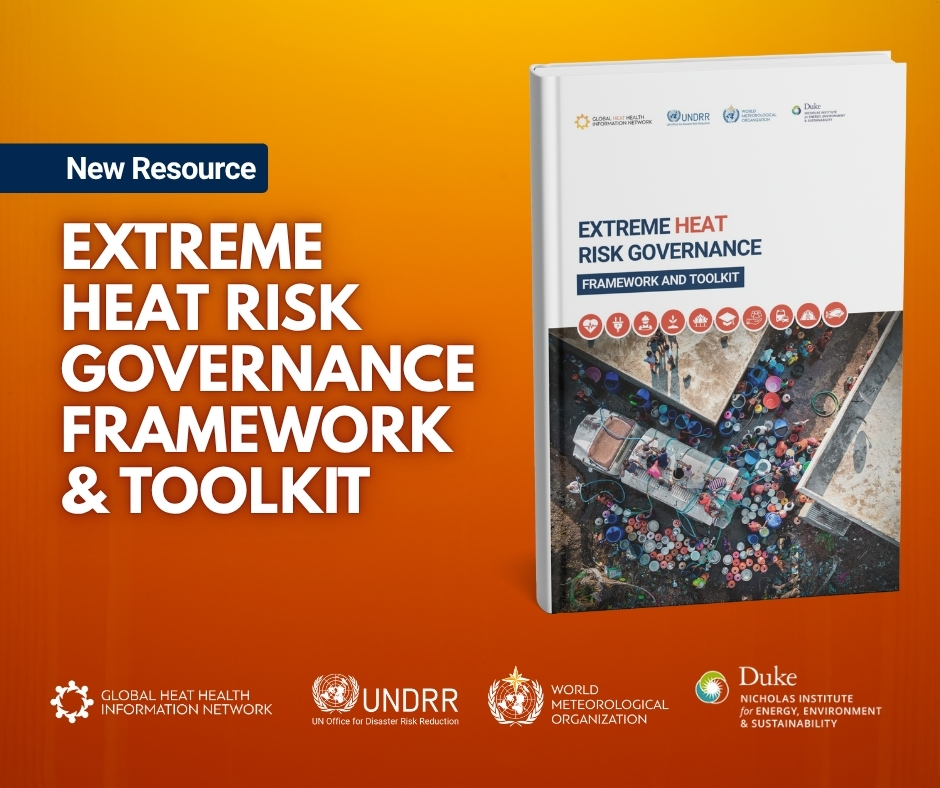Global Partners Release Framework & Toolkit to Build Heat Resilience Across Sectors
Published: November 11, 2025
…
The Global Heat Health Information Network (GHHIN), the United Nations Office for Disaster Risk Reduction (UNDRR), and the World Meteorological Organization (WMO) have launched a new resource to help governments and partners better prepare for and manage rising heat risks: the Extreme Heat Risk Governance Framework and Toolkit.
Extreme heat is one of the world’s most dangerous climate challenges, threatening health, livelihoods, and infrastructure. This new resource provides concrete practical tools for national and local authorities to assess and strengthen coordination, planning, and investment to protect people and systems from escalating heat impacts.

Launched at COP30 in Belém, Brazil, on 11 November 2025 at a high-level side event hosted by Luxembourg, the Framework presents a comprehensive understanding of the complexity of managing heat risk across sectors and timescales, and how elements of governance are fundamental to heat risk management. The toolkit shows readers how to identify concrete ways governments, communities, and institutions can work together by understanding and leveraging the roles of multiple actors; creating robust information systems; and taking aligned steps together to establish mechanisms that improve cross-sectoral coordination that reduces risks in the short, medium, and long term.
It offers a flexible, evidence-based approach that can be adapted to any setting, whether a low-resource community, a metropolitan area, or a national government.
Three core tools help decision makers come together to put the framework into action:
- Assess the Maturity of your Extreme Heat Risk Governance
This tool helps governments and partners take stock of how developed their key mechanisms are to manage extreme heat. It looks at five areas – awareness, leadership, response, resources, and collaboration – to find what’s working well and what needs improvement. - Operationalize Extreme Heat Risk Governance
This tool helps turn plans into more effective coordinated actions. It walks users through a four-step cycle – Demand, Plan, Act, and Learn & Improve – to strengthen cooperation, alignments, information sharing, and capacity across sectors. - Plan for Heat Action
This tool helps identify the key components that make a Heat Action Plan robust and effective. It includes examples and tips to support long-term planning and cooperation across sectors, helping communities become more resilient to extreme heat.
A series of case studies and technical resources are included in the toolkit to help partners learn from others.
These tools are designed for use by a range of actors, such as government agencies, urban planners, public health authorities, emergency managers, development partners, and investors. They support more inclusive, data-driven, and equitable governance of extreme heat, ensuring that efforts to prevent and respond to heat are coherent and sustainable.
“This Framework provides partners with a clear path and concrete tools to move from fragmented efforts to coordinated systems that saves lives and builds resilience,” said Joy Shumake-Guillemot, lead of the WHO-WMO Climate and Health Joint Programme and co-lead of the Global Heat Health Information Network. “It is practical, adaptable, and it is informed by science and experience.”
Developed through collaboration and consultation with more than 130 global experts and institutions, the Framework incorporates lessons from real-world case studies across different regions. It will be piloted in several countries in 2026, with future updates informed by local experience and feedback.
——
—–
Media Contact:
Maddie West, info@ghhin.org
Learn more: